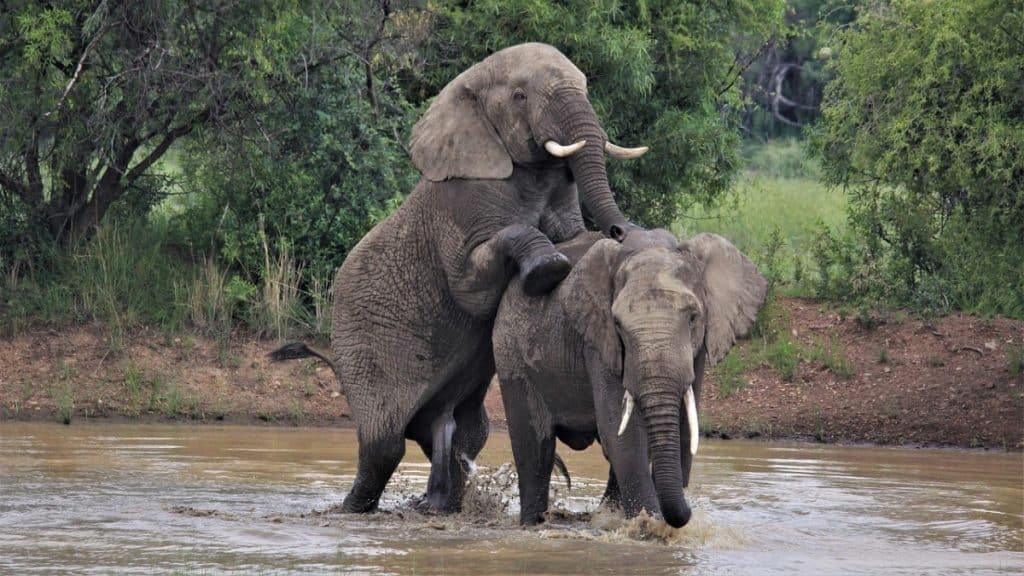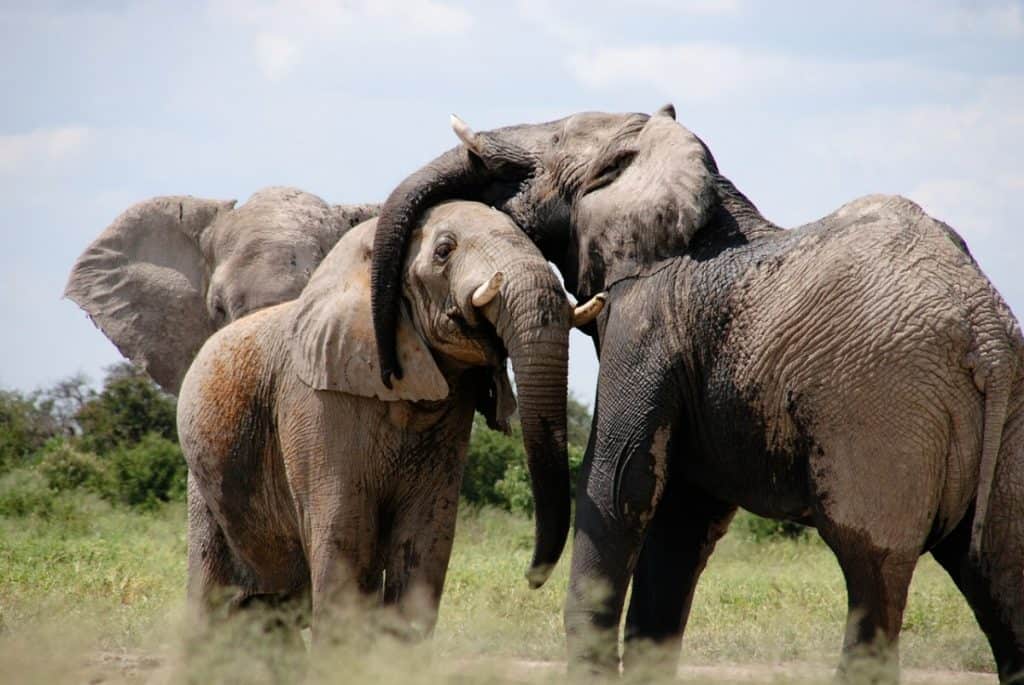The lifecycle of an elephant is one of the most fascinating and unique in the animal kingdom. From its humble beginnings as a helpless baby to its rise as one of the largest land mammals, we can learn a lot from elephants.
The journey they take during their lifetime is truly remarkable and filled with many milestones that shape them into who they are today. In this article, you’ll discover the different stages elephants go through throughout their life cycle and what happens during each phase.
Do you know how large elephants are? Find out here

Elephant Reproduction
Elephant reproduction is an important part of their lifecycle. Here we will look at the process and what’s involved in it.
The reproductive cycle of elephants follows a roughly three-year pattern, beginning when they reach sexual maturity around age 10 to 12. Male and female elephants are generally able to mate year-round. During mating season, male elephants go into musth, characterized by increased testosterone levels leading them to become more aggressive. When females enter estrus or heat, males compete for her attention as she chooses a mating partner.
Once a pair has mated successfully, gestation lasts about 22 months for African elephants and between 18-22 months for Asian elephants before the calf is born, weighing up to 200 pounds.
The calf relies on its mother’s milk for nutrition until it reaches two years old but can begin eating grass after four to six. As mothers within herds help each other raise calves, young ones often socialize with multiple adults who provide guidance and protection from predators like lions and tigers.
At 6-8 years of age, both males and females become fully independent and leave their family units to join bachelor herds or form new families. Over time this continues the cycle of elephant reproduction so that they can thrive in their natural habitats across Africa and Asia.
Do you know how good an elephant’s senses are? Find out here
Elephant Gestation Period
Elephant gestation periods last around 22 months, making them one of the longest mammal pregnancy cycles. During this time, a female elephant’s body undergoes many changes to prepare for motherhood. The cycle begins with an initial hormone surge that triggers ovulation and the release of eggs from her ovaries.
During gestation, a female increases her intake of food and other nutrients, such as calcium and phosphorus, to support fetal development and nourish herself through lactation after giving birth.
Elephants also get more sleep during their pregnancies than usual; they may spend up to 18 hours a day sleeping or resting to conserve energy for labor and nursing afterward. In addition, pregnant elephants tend to stay close together in herds so they can share resources like food sources, protection against predators, and companionship while going through these lengthy pregnancies.
At the end of the 22 months, female elephants are ready to give birth and welcome their new calves into the world. Births usually occur at night under the watchful eyes of experienced matriarchs who help guide both mother and calf throughout the process until separation occurs several weeks later when it is safe for them both to be on their own.
Do you know how to distinguish between an Asian and an African elephant? Find out here.
Elephant Weaning
The next stage of the elephant lifecycle is weaning. During this period, the calf will begin to eat solid food and become less dependent on its mother’s milk. This process can start as early as a few months after birth but typically occurs around two years of age. Weaning is an important milestone in a young elephant’s life, allowing them to develop independence while still having access to protection from their herd.
At first, calves can only consume soft fruits and plants pre-chewed by adult elephants or ground into a paste-like consistency. As they grow older, they can slowly add harder plant matter, such as bark and roots, to their diet.
In addition to providing nutritional benefits, weaning serves social functions within the herd structure. Older herd members teach younger elephants how to properly groom themselves and recognize food sources in different areas, which helps strengthen family ties between generations.
The transition from infancy to adulthood often happens gradually over several years, with multiple stages, including weaning, helping ensure each individual receives adequate support during key life changes.
Weaning marks an important development step for baby elephants, enabling them to move towards self-reliance while continuing their integration within the larger group setting.
Do you know why elephants are mammals?

Elephant Development
The development of an elephant is complex and fascinating. Elephants go through many stages as they mature into fully grown adults. The first stage in their lifecycle begins before the calf is even born when its mother carries it for 22 months before giving birth to a live calf.
Once the baby elephant is born, it will stay close to its mother’s side while she teaches it everything it needs to know about life and survival in the wild. As the young elephant ages, it will become more independent and spend time with other elephants.
During this period, calves learn important social skills such as communication and cooperation, which are essential for adult life in their herd or family group.
In adulthood, male elephants may leave their families to form bachelor herds or join existing ones. Female elephants remain together until maturity. However, once adult males have reached sexual maturity (around 15-20 years old), they may challenge each other for dominance within their herd to secure access to a mate. This process helps ensure genetic diversity within the population by allowing new individuals with different genes to mate with females from another group.
Elephant Longevity
Elephants have an average life expectancy of 50 to 70 years, though some may live longer depending on their environment and health. When they reach adulthood, elephants will enter a period of reproductive maturity that can last anywhere from 10 to 40 years. During this time, female elephants may give birth up to seven times throughout their lifetime.
In terms of aging, studies show that elephants are similar to humans in many ways. Older elephants tend to suffer more ailments and decreased fertility as they age. In particular, adult females experience hormonal changes during menopause, often leading them into a state of infertility after 45-50 years old.
It’s also worth noting that while male elephants typically outlive their female counterparts due to being less exposed to danger or physical threats over time, they still face challenges related to declining health as well as social conflict within herds due to competition among younger males trying to establish dominance in the herd hierarchy.
Elephant Mortality
The mortality rate of elephants is an important factor to consider when discussing elephant conservation. The lifespan of this species can be anywhere from 40-70 years in the wild, depending on factors like habitat and access to resources.
Elephants are particularly vulnerable during their first few years since they rely so heavily on protection and guidance from experienced adults. Sadly, many calves do not make it past infancy due to various threats such as poaching, predation, disease, or lack of food.
Elephant mortality has severe impacts beyond individual animals, as entire populations can suffer if too much of the population die off prematurely. This means that all efforts should be taken to ensure survival rates remain high, especially among young individuals who may otherwise struggle without parental support.
One way this could be achieved is by creating protected areas where natural predators cannot reach them and ensuring a plentiful supply of resources for mothers-to-be and nursing families.
We must take steps to reduce illegal hunting and culling operations which often target healthy adult members of the herd with no regard for offspring or future generations. Furthermore, human activities such as logging can drastically alter habitats, which become unsuitable for safely raising young elephants. Education about sustainable development practices is essential for fighting against this issue going forward.
We have seen just how critical mortality rates are when maintaining healthy elephant populations across Africa’s savannahs and forests; if nothing changes soon, this incredible species could face extinction before long unless we work together towards protecting them now.
References and Further Reading
The Amboseli Elephants: A Long-Term Perspective on a Long-Lived Mammal” by Cynthia J. Moss
“The Elephant: The Animal and Its Ivory in African Culture” by Keith Somerville
“Elephants: A Cultural and Natural History” by Jeremy Griffiths
“The Secret Life of Elephants: A Love Story” by Sharon Guynup
Where Elephants Weep: The Story of an Indian Elephant Family” by Camille Coudari
“Elephants on the Edge: What Animals Teach Us about Humanity” by G. A. Bradshaw
“Elephants and Ethics: Toward a Morality of Coexistence” by Christopher J. Preston
The Diversity of Mammals” by David Macdonald and Priscilla Barrett
